Disease-resistant and easy-care tomato "Pink Stella": reviews, photos and secrets of getting a bountiful harvest
The variety of pink tomatoes is so great that you are often at a loss as to which one to choose. The variety Rosova Stella definitely stands out from many others for the taste of the fruit. Ripe raspberry-colored vegetables are saturated with vitamins B and C. A small percentage of acidity allows the use of fruits for baby and dietary nutrition. Small compact bushes will decorate any summer cottage. The culture is so unpretentious in its care that it is recommended even for novice gardeners.
This article provides a photo and description, characteristics and reviews of the Pink Stella variety.
The content of the article
Characteristics and description of the variety
Tomato variety Rose Stella bred by Altai breeders and is intended for breeding in warm regions, but is successfully grown in areas with temperate and cold climates. It takes root equally well both in greenhouse conditions and in open beds.
Distinctive features
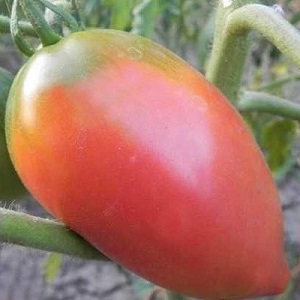 Determinant type, standard, compact, 50-60 cm high... The foliage is medium, the leaves are elongated, dark green. 6-7 fruits are tied in one brush, brushes are formed often, through 1 leaf.
Determinant type, standard, compact, 50-60 cm high... The foliage is medium, the leaves are elongated, dark green. 6-7 fruits are tied in one brush, brushes are formed often, through 1 leaf.
Mid-early variety, from the moment of sowing the seeds to full maturation, 105-110 days pass.
The yield is excellent, up to 3 kg of fruits are harvested from 1 seedling, provided that 3 plants are planted per 1 sq. m.
Culture immunity is based on high resistance to most insect pests and diseases typical of the nightshade family.
Stunted bushes It does not require pinching, but you cannot do without a garter: the fruit-bearing branches cannot withstand the weight of ripe vegetables.
Fruit characteristics
Average weight of one tomato - 170-180 g, pepper-shaped, elongated, pink-crimson color. The taste is pronounced, sweet-dessert with barely noticeable acidity, the pulp is juicy. The peel is thin, but dense, cracking in dry weather with a lack of moisture. There are 4 seed chambers, few seeds.
The purpose of tomatoes is universal: they are used fresh and for winter preparations. Suitable for processing into tomato products. Ripe tomatoes produce excellent juices, not only canned, but also freshly squeezed.
The photo shows the pink Stella tomatoes.
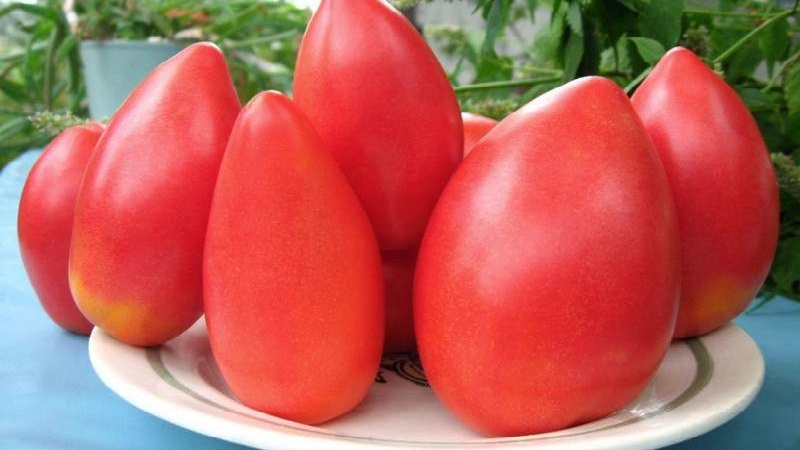
How to grow seedlings
Sowing seeds for seedlings begins 2 months before planting in the ground... The sowing material is harvested independently, since the variety is not hybrid, which means that the varietal qualities are preserved in the next generation.
Seed preparation
The seeds are laid out on the table and carefully examined for visible damage. Applicable specimens must be light in color and free from distortion. Then they are dipped in saline solution for 10 minutes. This is how they check whether the grains are empty or not. Those that surfaced are not suitable for landing. After the grain is disinfected in a weak solution of pinkish potassium permanganate for 20 minutes. Then washed with running water and dried.
To improve germination seeds are soaked in a growth stimulator for 12 hours.
Reference. In addition to specialized preparations, melt water or aloe juice is used as growth stimulants.
Capacity and soil
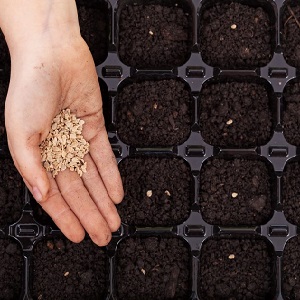 The soil is prepared from turf, peat and humus in a ratio of 2: 2: 1... All components are thoroughly mixed and the resulting mixture is disinfected by calcining in the oven for 15 minutes at a temperature of 50 ° C. Another way is to spill the soil with a hot potassium permanganate solution.
The soil is prepared from turf, peat and humus in a ratio of 2: 2: 1... All components are thoroughly mixed and the resulting mixture is disinfected by calcining in the oven for 15 minutes at a temperature of 50 ° C. Another way is to spill the soil with a hot potassium permanganate solution.
After the soil has cooled, it is laid out in planting containers, having previously made small drainage holes at the bottom, where excess moisture will drain.
Placed in a common wooden box or individual containers... Plastic cups and peat pots are the most frequent and convenient way to breed seedlings, since when planted in a separate container, seedlings grow and develop better. In addition, plastic containers are lightweight, which does not cause difficulties when transporting planting containers to a summer cottage.
Reference. The disinfected soil is the key to healthy and strong immunity of seedlings.
Sowing
Seeds are sown in 1 cm deep grooves at a distance of 1-2 cm from each other... Sprinkle on top with earth, level and slightly moisten with warm, settled water. Then the containers are covered with foil or glass to create a greenhouse effect and left in a warm room at a temperature of 23-24 ° C. The film is periodically removed for ventilation and, as necessary, the topsoil is moistened.
Growing and care
1 week after sowing, the appearance of the first shoots is noticeable... The film is removed, and the containers are rearranged on the windowsill, but not on direct sunlight. The duration of daylight hours should be at least 14 hours, so there is a need for additional lighting with fluorescent lamps.
Reference. Direct sunlight can burn young plants.
Water as the topsoil dries out along the edge of the nursery with warm, settled water with a shallow watering can. After watering, the soil is loosened superficially, without touching the young roots.
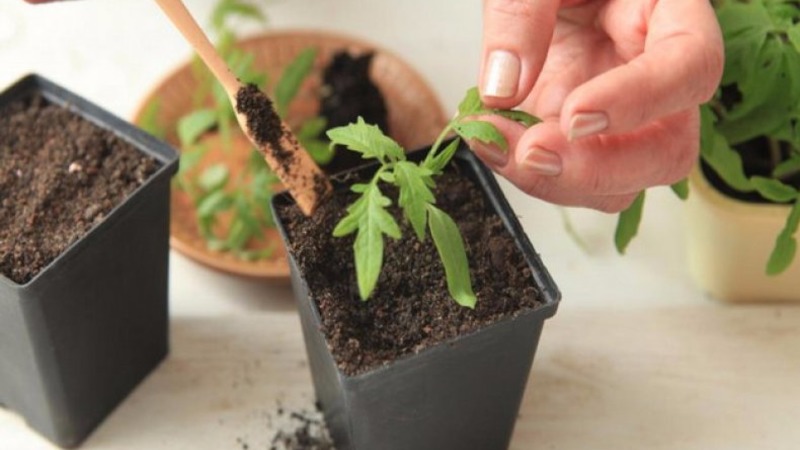
Indoor temperature during seedling season maintain at around 22 ° C, and the night temperature should not fall below 16 ° C.
No need to water abundantly, since the sprouts will begin to stretch, which is undesirable in the initial period. In order for the seedlings to grow straight, they are periodically turned to the window in different directions.
About other varieties of pink tomatoes:
A variety with an amazing taste - the Raspberry Giant tomato
Early ripe tomatoes for juices, salads and preservation "Fatima"
Mid-season variety with fruits, as in the picture - "Major" tomato
After the appearance of 2-3 true leaves, the seedlings dive, seating in separate containers. After picking, the seedlings intensively build up the root system, which has a beneficial effect on plant growth.
2 weeks before planting in the ground, the seedlings begin to harden, taking it outside during the day for 1 hour at a temperature of 17-18 ° C. The time spent outdoors is gradually increased to 12-14 hours. Simultaneously with the daytime hardening, the night temperature in the room is reduced to 13 ° C.
How to grow tomatoes
After 55-60 days, the seedlings are ready for planting in the ground... Seedlings are planted on open beds 2 weeks later than in greenhouse conditions. By the time of transplantation, the soil should be warmed up to 16-17 ° C.
Landing
Before planting tomatoes, the soil is treated with copper sulfate at the rate of 1 tablespoon per 1 bucket of water for the prevention of fungal diseases. Then the soil is dug up with the introduction of mineral fertilizers.
Landing scheme: 40 cm - the distance between the seedlings, 60 cm is left between the rows. For 1 sq. m place 3 plants. They are planted in holes 20 cm deep, on the bottom of which a little wood ash is previously placed. After transplanting, the holes are compacted, watered with warm, settled water and the young bushes are left to adapt to new conditions for 9-10 days. During this period, the plants are not watered or fed.
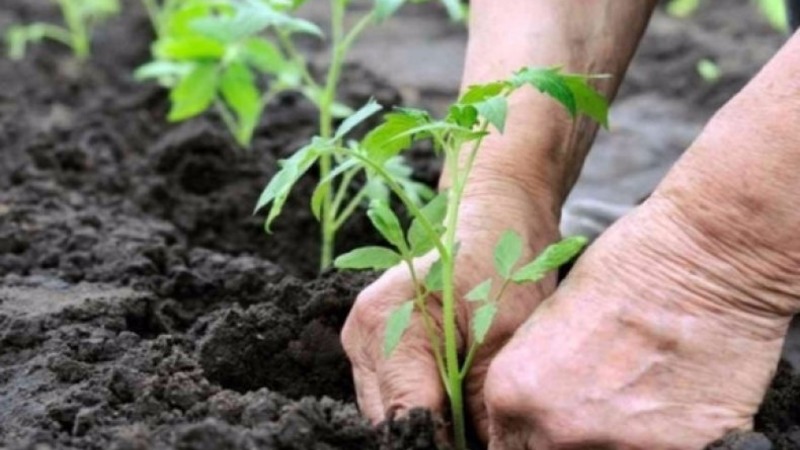
Further care
Regular watering is set no more than 2 times a week... The best time to water is in the evening or early morning.Pour warm water, under the root, without getting on the leaves. Sprinkling is discouraged, as in addition to sunburn, plants can develop apical rot. On dry days, the amount of watering is increased. Also, the culture consumes more moisture during the formation of the fruit.
Reference. Sprinkling is a method of irrigation in which water, often with the help of special devices, is sprayed in the form of rain over the soil surface and plants.
After watering, the soil is loosened, removing weeds with roots... Loosening saturates the root system with oxygen and disrupts the habitual habitat of many pests living in the earth.
Hilling, like loosening, promotes better oxygen penetration and strengthens the rhizomes, thereby forming a strong stem. Hilling is carried out during the season no more than 3 times. This is quite enough for the formation of a full-fledged stem.
Throughout the growing season, the culture is fed 4 times:
- The first top dressing is applied 3 weeks after transplantation. Fertilizers - "Ideal" and "Nitrofoska". 1 tbsp. l. dissolve in 1 bucket of water and pour 0.5 l under the bush.
- During flowering, a second top dressing is applied with the "Signor Tomato" fertilizer at the rate of 1 tbsp. l. for 1 bucket of water. For each seedling, 1 liter of solution is consumed.
- The third feeding is made 10-12 days after the second. Fertilize with "Ideal" and "Nitrofoskaya" in the same proportions as for the first time.
- Fertilize with superphosphate for the fourth time. The solution is prepared from 1 tbsp. l., diluted in 1 bucket of water. For 1 sq. m consume 10 liters of solution.
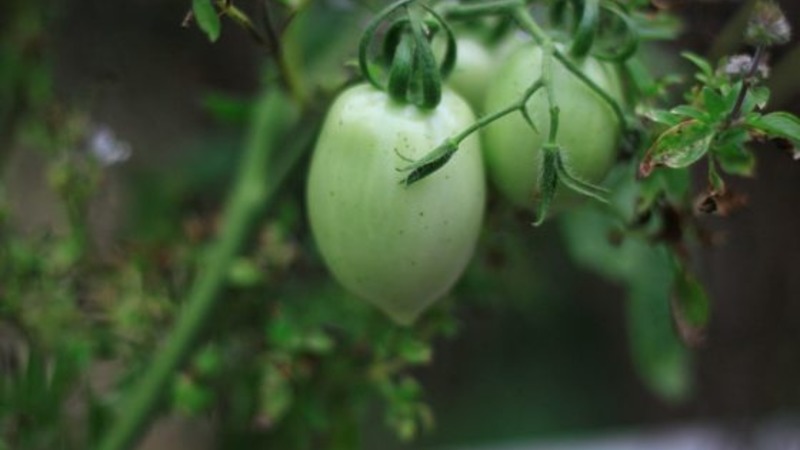
Features in care and possible difficulties
Undersized bushes do not require grazing... They are formed into 3 or 4 stems, all other shoots are removed. The plant does not throw out lateral shoots in the future, therefore they are not stepchildren. Large leaves that prevent the penetration of sunlight are cut off. Also remove those branches that have ceased to bear fruit.
For a garter, a wooden or metal support is installed next to each bush during transplantation., to which the stem is fixed. Immediately upon transplant, the stem is tied up so that it grows even. In the future, fruitful branches are also fixed to the support, since they do not support the weight of ripe vegetables.
Diseases and pests
The culture is distinguished by strong immunity to tobacco mosaic virus and late blight... But it is susceptible to attacks of the Colorado potato beetle, which cause irreparable harm to plants. In addition, females lay eggs on the back of the leaves, which cannot be seen unless the leaves are turned over when examining the plants. Colorado potato beetle larvae are no less dangerous than adults.
To scare away this pest, mustard bushes are planted next to the tomatoes.... Their pungent smell irritates many insects, and they try not to approach such beds. If the insect managed to breed in large quantities, use the drug "Prestige". Otherwise, all the leaves will be eaten and the culture will die.
Attention! The most effective preventive method is to regularly inspect the seedlings for changes due to disease or the presence of pests. It is always easier to prevent any problem than to deal with it later.
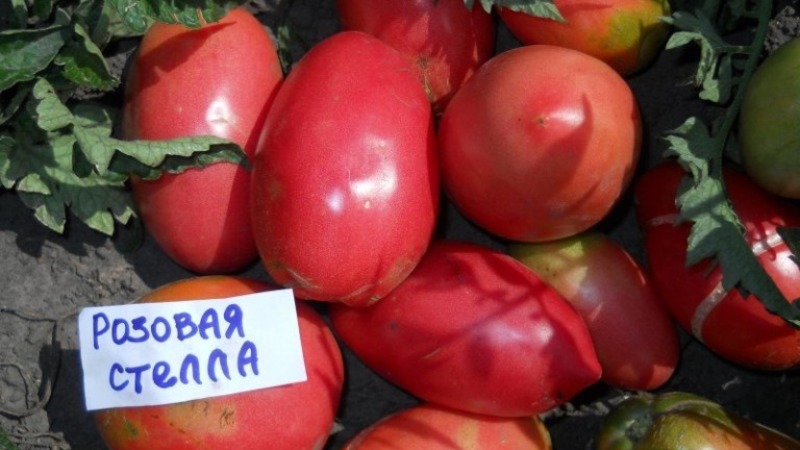
The nuances of cultivation in the open field and in the greenhouse
The culture is intended for cultivation in open ground and in greenhouse conditions... In greenhouse plants, the height practically does not differ from that of street plants, they are just as low and compact. Temperature differences do not affect the quantitative indicator, since the tomato is adapted to lowering the temperature regime.
The culture is demanding on lighting, starting from the seedling period... With a lack of light, young plants stretch out, and later in shaded areas, ripening occurs later, and small fruits are formed.
Moderate watering is essential to prevent cracking of ripe vegetables... If the plant is not watered for a long time in dry weather, and then immediately carry out abundant watering, an excess of moisture will negatively affect the taste and quality of the tomatoes.
Ideal predecessors of tomatoes - winter crops or legumes, carrots, cabbage, cucumbers. Crop rotation rules strongly recommend not planting tomatoes in the place where crops from the Solanaceae family grew before. They extract most of the nutrients from the soil, so the tomato will experience a constant lack of beneficial trace elements in depleted soil.
Harvesting and application of the crop
Harvesting begins in late July - early August and due to long-term fruiting, it continues until the first frost. Ripening is not amicable, the last tomatoes are removed green. They ripen perfectly at home, while in the beds at this time, the risk of fungal diseases increases.
The purpose of tomatoes is universal: They are used to prepare a variety of dishes, from the simplest summer salads to hot and vegetable dishes. Ripe vegetables produce excellent freshly squeezed and canned juices, where the sourness characteristic of tomato appears. Also, tomatoes do not lose their taste in barrel salting, pickles and processed tomato products: ketchups, pastes, lecho, adjika.
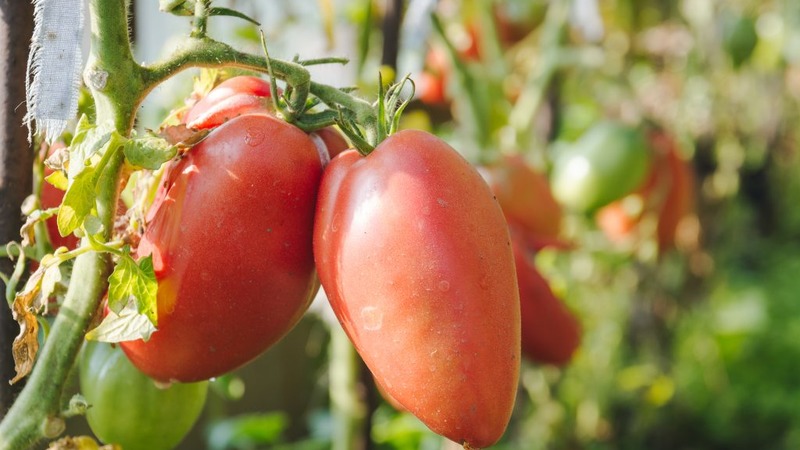
Advantages and disadvantages of the variety
The variety has many positive characteristics.:
- short bushes;
- unpretentious care;
- adaptation to any weather conditions;
- does not require pinning;
- persistent immunity to disease;
- excellent productivity;
- excellent fruit taste;
- long-term fruiting;
- versatility in cooking;
- long storage;
- long transportation.
The negative sides include compulsory garter and constant moderate watering, otherwise the peel of vegetables will crack.
Read also:
Farmers reviews
Several gardeners reviewspreferring this crop to other varieties of tomato.
Natalia, Magnitogorsk: “My favorite variety. I have been planting it for many years and will never refuse. Unpretentious and not sick, not afraid of bad weather, always gives abundant fruiting. It is versatile in cooking, the fruits are beautiful and tasty. I advise everyone ".
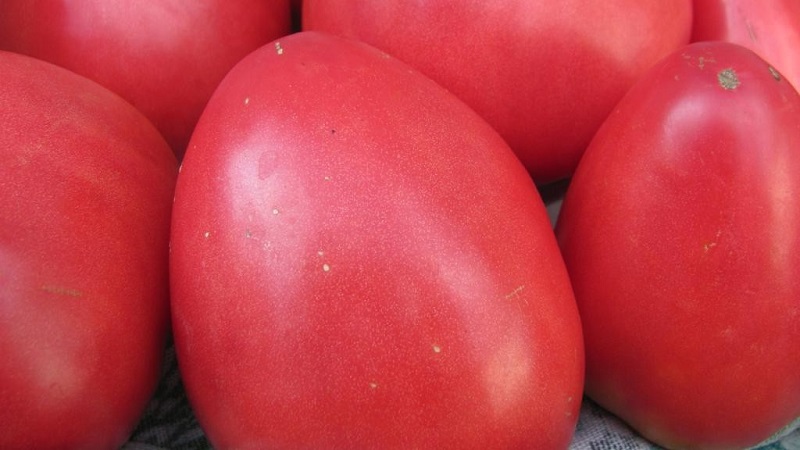
Vladimir, Samara: “For the first time I saw a tomato in photographs, impressed me with its low growth and excellent yield. Grew up in the open field, from 1 seedling collected almost a bucket of delicious vegetables. I especially liked the preserves and fresh salads ".
Conclusion
Tomato Pink Stella is a great option for those who are first going to grow a tomato crop on their site. He calmly endures agronomic mistakes, presenting with magnificent pepper-like fruits. The variety is characterized by strong immunity to many diseases, so that gardeners do not waste time saving the harvest. In a word, this variety is for those who want to remember the summer cottage season with pleasant chores, and not exhausting work.